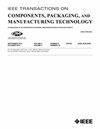Low-Temperature Solid-State Bonding of Microbumps Arrays With Flat-to-Convex Structure via Plasma-Induced Silver Oxide Nanoparticles
IF 2.3
3区 工程技术
Q2 ENGINEERING, ELECTRICAL & ELECTRONIC
IEEE Transactions on Components, Packaging and Manufacturing Technology
Pub Date : 2025-01-22
DOI:10.1109/TCPMT.2025.3532769
引用次数: 0
Abstract
For advanced 3-D-IC packaging, we have previously invented a new bonding technology utilizing plasma-induced Ag2O nanoparticles (Ag2O NPs) and disclosed the growth mechanism of plasma-induced Ag2O NPs. In this study, we first established suitable parameters for the growth of plasma-induced Ag2O NPs on Ag films deposited by magnetron sputtering. Moreover, a novel structure, namely a flat-to-convex structure, was designed to facilitate the bonding of a microbump array and a surface of plasma-induced Ag2O NPs atop the as-deposited Ag film. This structure enhances the localized pressure at the interface between the microbumps and the film, thereby promoting the lateral plastic deformation of the microbumps. Additionally, the Ag-Ag direct bonding of flat-to-convex structure was achieved by applying an oxygen and argon plasma to the surface of Ag films, followed by in situ reduction of plasma-induced Ag2O NPs under a low temperature (针对先进的三维集成电路封装,我们之前发明了一种利用等离子体诱导的 Ag2O 纳米粒子(Ag2O NPs)的新型键合技术,并揭示了等离子体诱导的 Ag2O NPs 的生长机理。在本研究中,我们首先确定了在磁控溅射沉积的银薄膜上生长等离子体诱导的 Ag2O NPs 的合适参数。此外,我们还设计了一种新型结构,即平面到凸面结构,以促进微凸块阵列和等离子体诱导的 Ag2O NPs 表面在沉积的银薄膜上的结合。这种结构增强了微凸块和薄膜之间界面的局部压力,从而促进了微凸块的横向塑性变形。此外,通过在银膜表面施加氧气和氩气等离子体,然后在低温(220~^{\circ }$ C)下原位还原等离子体诱导的 Ag2O NPs,实现了平凸结构的银-银直接结合。氧化银的原位还原润湿了原始界面,增强了表面扩散,促进了原子尺度上的材料连接,以及原始键合界面上晶粒的合并。这为倒装芯片互连和三维集成电路异质集成中的应用提供了一种高度可靠的设计。
本文章由计算机程序翻译,如有差异,请以英文原文为准。
求助全文
约1分钟内获得全文
求助全文
来源期刊

IEEE Transactions on Components, Packaging and Manufacturing Technology
ENGINEERING, MANUFACTURING-ENGINEERING, ELECTRICAL & ELECTRONIC
CiteScore
4.70
自引率
13.60%
发文量
203
审稿时长
3 months
期刊介绍:
IEEE Transactions on Components, Packaging, and Manufacturing Technology publishes research and application articles on modeling, design, building blocks, technical infrastructure, and analysis underpinning electronic, photonic and MEMS packaging, in addition to new developments in passive components, electrical contacts and connectors, thermal management, and device reliability; as well as the manufacture of electronics parts and assemblies, with broad coverage of design, factory modeling, assembly methods, quality, product robustness, and design-for-environment.
 求助内容:
求助内容: 应助结果提醒方式:
应助结果提醒方式:


